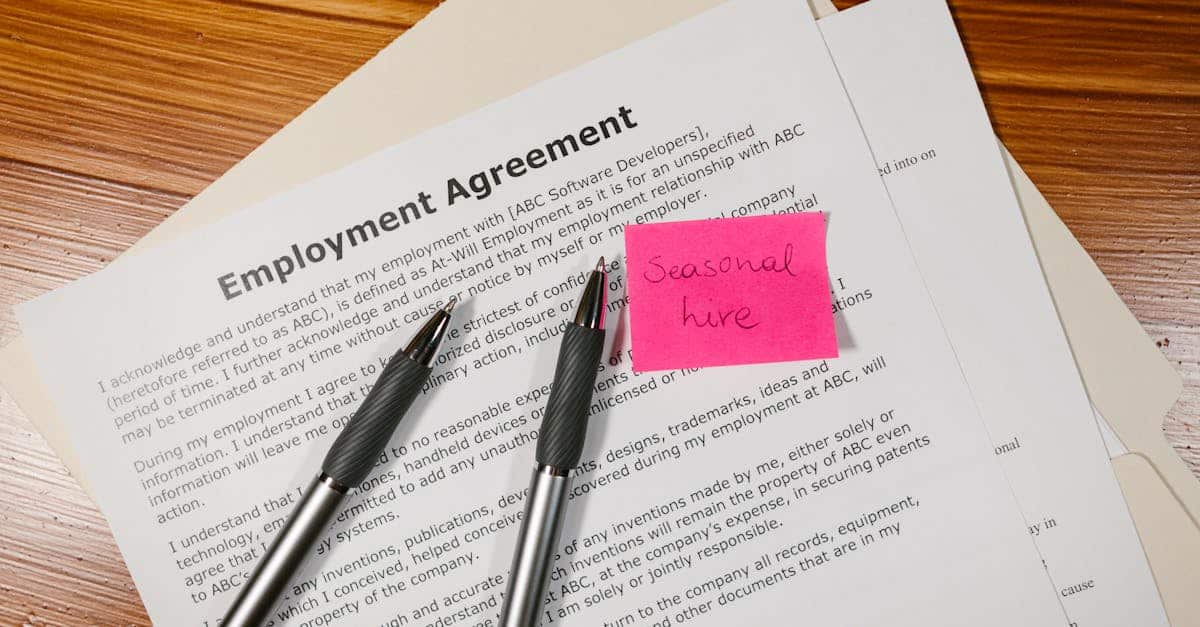
Introduction
Hiring at pace, shifting regulations, and hybrid workplaces have made one thing clear: a sloppy contract creates costly confusion. Vague obligations, inconsistent pay language, and overbroad covenants slow onboarding, spark disputes, and multiply legal risk—so HR and in‑house counsel need a practical, clause‑by‑clause approach that keeps hires moving and limits exposure.
Whether you’re drafting employee agreements for a startup or updating templates for a global team, this guide walks through the essential clauses (duties, compensation, term and termination), pay and benefits drafting, confidentiality and IP assignment, jurisdictional addenda, and enforcement‑friendly covenant options. It also shows how document automation—clause libraries, auto‑fill fields and approval/version workflows—can standardise outcomes, cut drafting time, and preserve legal oversight. Read on for clear templates, drafting tips, and practical automation steps you can use today.
Core sections to include and why they matter (duties, compensation, term, termination)
What to put first: An employee agreement (often used interchangeably with employment contract or workplace agreement) should clearly define the parties, the role, and the baseline legal relationship. Clarifying the basics up front reduces disputes about scope and status later.
Essential clauses
- Duties and responsibilities: Precise job description, reporting lines, location (remote/hybrid), and any mobility/secondment expectations.
- Compensation: Base salary, pay frequency, overtime rules, superannuation/pension and payroll classifications (employee vs contractor).
- Term and probation: Fixed-term vs ongoing, probation length and performance review triggers.
- Termination: Notice periods, cause for summary dismissal, garden‑leave, and post‑termination obligations.
Use an employee contract template or an employee agreement template to standardise these sections across roles. If you need a practical starting point, see an example employment agreement form you can adapt: https://formtify.app/set/employment-agreement-mdok9.
Checklist (quick)
- Role, title, and duties
- Salary, pay dates, and bonus eligibility
- Start and end dates or probation period
- Termination rights and notice obligations
Drafting pay, bonus, probation and benefits clauses to reduce ambiguity
Pay and salary clauses: State the gross amount, pay frequency, and whether pay is pro‑rata for part‑time roles. Define tax treatment and payroll deductions.
Bonuses and incentives: Distinguish between discretionary and contractual bonuses. If a bonus is promised, include the formula, performance metrics, payment timing, and clawback conditions.
Probation periods: Spell out the duration, evaluation criteria, extension rights and what happens at successful completion (e.g., change in notice period). Clarify termination during probation to avoid implied long‑term commitments.
Benefits and perks: List benefits (health insurance, leave entitlements, equity, allowances) and eligibility rules, vesting schedules for equity, and any conditions for loss of benefits on termination.
Drafting tips
- Use plain language and numeric triggers (dates, percentages, thresholds).
- Avoid vague phrases like “may” when the intention is mandatory.
- Include examples where formulas are used (bonus calculations, pro‑rata examples).
- Link offer specifics to a job offer letter or separate schedule: https://formtify.app/set/job-offer-letter-74g61.
Confidentiality, IP assignment, and restrictive covenant options (non‑compete vs non‑solicit)
Confidentiality / employee confidentiality agreement: Define what is confidential, permitted disclosures, duration of the obligation, and return/destruction requirements. Consider including examples (customer lists, pricing, source code).
IP assignment: Require assignment of work product created in the course of employment and include moral‑rights waivers where permitted. Specify the scope (inventions, designs, code) and any carve‑outs for pre‑existing IP.
Restrictive covenants — overview: Employers commonly use non‑compete, non‑solicit, and non‑poach clauses to protect business value. Draft them narrowly to improve enforceability: limit by geography, duration, and protected activities.
Non‑compete vs non‑solicit: practical differences
- Non‑compete agreement: Stops an ex‑employee from working in competing businesses for a defined period/place. Often the most scrutinised and sometimes unenforceable if too broad.
- Non‑solicit: Prohibits approaching the employer’s clients or employees for a period after termination. Generally easier to enforce if limited to specific customers or staff categories.
Drafting checklist:
- Define legitimate business interest being protected.
- Set clear duration (typically 3–12 months depending on jurisdiction).
- Limit scope to necessary activities and customers.
- Consider compensation or garden‑leave for long restrictions.
For a starting clause or a formal non‑compete agreement, see a template you can adapt: https://formtify.app/set/non-compete-agreement-bouwz.
State and jurisdiction considerations: addenda, mandatory notices, and limits on covenants
Local law matters: Employment law varies widely—employment contracts enforceability, mandatory notices, and allowable covenant lengths depend on the state or country. For example, some U.S. states restrict non‑competes entirely; Australia and EU states have their own rules and notice requirements.
Addenda and local schedules: Maintain jurisdictional addenda to capture statutory entitlements (minimum leave, workplace safety notices, superannuation/pension rules, tax forms). Keep a master template and attach local schedules per hire.
Mandatory notices and privacy: Include required notices such as right to work, payroll tax forms, and privacy statements about employee data handling. Cross‑reference your data‑retention and access policies.
Limits on covenants
- Check state‑specific time limits and reasonableness tests.
- Be aware of exemptions for certain worker categories (e.g., low‑paid employees in some jurisdictions).
- Use local counsel for high‑risk roles or senior executives, and document why the covenant is reasonable.
Practical step: Keep an “employee agreements australia” schedule if you hire there, and add state/country addenda as part of onboarding to ensure the agreement complies with local mandatory terms.
Using Formtify to automate clause libraries, auto‑fill fields and generate tailored agreements
Why automate: Standardising employee agreements reduces drafting time, lowers legal risk, and creates consistent outcomes across hires. Automation helps HR scale contract management for HR while preserving legal oversight.
How Formtify helps: Build a clause library (confidentiality, IP assignment, notice periods, probation language), then select clauses per role. Auto‑fill fields such as names, dates, salary and jurisdiction to produce consistent employment contracts and workplace agreements.
Practical uses
- Generate an offer from a job offer template quickly: https://formtify.app/set/job-offer-letter-74g61.
- Spin up a tailored employment agreement from stored clauses: https://formtify.app/set/employment-agreement-mdok9.
- Attach specific covenants like a non‑compete when appropriate: https://formtify.app/set/non-compete-agreement-bouwz.
Tips for setup: Tag clauses with meta‑data (jurisdiction, role seniority, enforceability notes). Maintain an “employee agreements sample” repository so HR can reference past language and negotiation outcomes.
Approval, signature and version control workflows to keep agreements enforceable
Approval workflows: Define who must sign off before an agreement is issued (HR, hiring manager, legal). Use role‑based approvals to prevent unapproved exceptions that may create enforceable obligations.
Signatures and execution: Decide on signing method (wet signature, e‑signature) and ensure your chosen method meets legal requirements in each jurisdiction. Record dates of signing and effective dates clearly.
Version control and audit trail: Store each signed version, plus the exact clause set used at execution. Keep a version history that records approver, timestamps, and change summaries to defend enforceability if challenged.
Operational checklist
- Pre‑issue checklist: role, compensation, covenants, jurisdiction addenda, signatures required.
- Require legal sign‑off for high‑risk covenants or senior hires.
- Log executed documents in a contract repository and link them to the employee record.
- Set reminders for expiry of fixed‑term contracts, probation reviews, and covenant end dates.
These steps protect enforceability and support later audits or employment disputes, giving HR and legal teams a clear playbook for contract management and negotiation.
Summary
Bottom line: A practical employee agreement is clause‑by‑clause work — clear duties, precise pay and benefits language, sensible term and termination provisions, airtight confidentiality and IP assignment, and narrowly drafted covenants — plus the right jurisdictional addenda. Getting those building blocks right reduces disputes, speeds onboarding, and protects business value.
Document automation amplifies those gains: use clause libraries, auto‑fill fields, and approval/version workflows to standardise language, cut drafting time, and keep legal oversight intact. Build and maintain your templates so HR can generate enforceable employee agreements consistently — start automating at https://formtify.app.
FAQs
What is an employee agreement?
An employee agreement is a written contract that sets out the core terms of the employment relationship, including role, pay, benefits, and notice provisions. It clarifies expectations for both sides, protects company IP and confidential information, and reduces the risk of later disputes.
Does an employee agreement have to be written?
Legal requirements vary by jurisdiction, and some places may recognise oral contracts, but a written agreement is strongly recommended. A written document improves enforceability — especially for confidentiality, IP assignment, and restrictive covenants — and provides a clear record for HR and legal teams.
Can an employer change an employee agreement?
Material changes to an agreement generally require the employee’s consent; unilateral changes can create legal risk or constructive dismissal claims. Employers can, however, rely on properly drafted policy and variation clauses for limited adjustments, but best practice is transparent communication and documented agreement to the change.
What should be included in an employee agreement?
Include clear sections for duties and reporting, compensation and benefits, term/probation, termination rights, confidentiality and IP assignment, and any restrictive covenants or jurisdictional addenda. Also specify signatures, effective dates, and any schedules (e.g., equity vesting or local law addenda) to keep obligations precise.
How long does an employee agreement last?
Duration depends on the type of agreement: fixed‑term contracts end on a set date, while ongoing contracts run until terminated by notice. Note that certain obligations — such as confidentiality or post‑termination non‑solicit covenants — can survive the employment relationship for a defined period.





